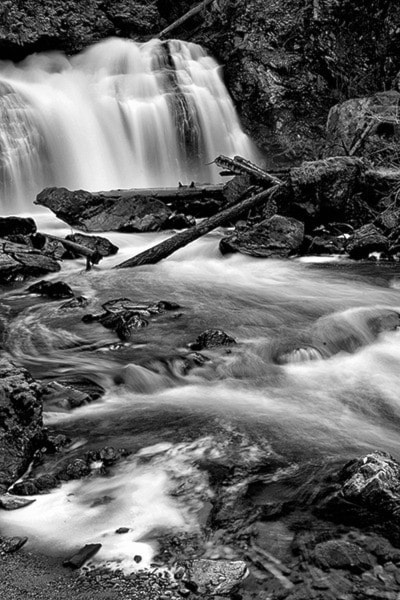Spring is here. The weather has slowly warmed up and I can see from my porch that the snow on the mountaintops is diminishing, so I decided it was time to visit a waterfall not far from my home.
I usually avoid waterfalls at this time of year because high volumes of murky, spring water rushing over the falls isn’t that photogenic, and one never knows if the river’s bank will give away while you position your tripod.
However, with the low volumes of water being reported I was sure that at Chase Creek Falls the interesting stream features like rocks and trees would be visible with the reduced water flow.
When I got to Chase Falls and parked my car I noticed a small sign along the trail that said to watch for a local marmot named “Chewy”. And sure enough, as I passed a large pile of very big rocks, there was a big marmot perched on top like some amusement park guard.
Marmots are usually shy when one walks near their burrow, but this rodent didn’t seem to be bothered in the least and readily posed for me as I hopped from rock to rock making portraits of him or maybe her. I did see a couple of immature marmots scurry out of sight; so I might be right thinking Chewy might be her instead him.
When I purchased my first DSLR years ago and began learning how to use Photoshop I remember saying to a friend that what I liked best was how easily one could crop without getting the degradation that came when cropping prints made from film.
The problem with 35mm film was that anything shot over 400ISO was always grainy so that shooting wide and cropping later was usually disappointing.
That’s why many photographers preferred medium or large format cameras to the tiny 35mm film.
I set my tripod up and focused my 24mm lens on the falls and shot wide. I knew that when I viewed my images on my computer I would choose a crop that fit the rule-of-thirds without loosing much detail.
Modern DSLR sensors are much better in their ability to capture grainless detail at high ISOs than 35mm film was and even cropping away 50 per cent of the picture doesn’t reduce the quality very much.
The low water level made it easy to scramble among the large rocks along the bank and choose a comfortable location to set my tripod up.
I used a couple of neutral density (ND) filters so I could reduce my shutter speed to 3, then 4, 5, and finally 6 seconds to slow the water down and I chose a small aperture for lots of depth of field.
I have always enjoyed photographing that waterfall. I think I made my first photographs of it sometime in 1976, and I cannot recall how many times I have been back there since. I am fortunate to have a place like that so close to home where I can always find something to photograph.
With that I think I should end with a quote by a great Canadian photographer, Freeman Patterson, who says, “Seeing, in the finest and broadest sense, means using your senses, your intellect, and your emotions. It means encountering your subject matter with your whole being. It means looking beyond the labels of things and discovering the remarkable world around you.”
These are my thoughts for this week. Contact me at emcam@telus.net or stop by Enman’s Camera at 423 Tranquille Road in Kamloops. I sell an interesting selection of used photographic equipment. And if you want an experienced photographer please call me at 250-371-3069.
